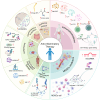Inflammatory Response and Anti-Inflammatory Treatment in Persistent Inflammation-Immunosuppression-Catabolism Syndrome (PICS)
- PMID: 39968098
- PMCID: PMC11834740
- DOI: 10.2147/JIR.S504694
Inflammatory Response and Anti-Inflammatory Treatment in Persistent Inflammation-Immunosuppression-Catabolism Syndrome (PICS)
Abstract
Many patients now survive their initial critical events but subsequently develop chronic critical illness (CCI). CCI is characterized by prolonged hospital stays, poor outcomes, and significant long-term mortality. The incidence of chronic critical illness (CCI) is estimated to be 34.4 cases per 100,000 population. The incidence varies significantly with age, peaking at 82.1 cases per 100,000 in individuals aged 75-79. The one-year mortality rate among CCI patients approaches 50%. A subset of these patients enters a state of persistent inflammation, immune suppression, and ongoing catabolism, a condition termed persistent inflammation, immunosuppression, and catabolism syndrome (PICS) in 2012. In recent years, some progress has been made in treating PICS. For instance, recent advancements such as the persistent expansion of MDSCs (myeloid-derived suppressor cells) and the mechanisms underlying intestinal barrier dysfunction have provided new directions for therapeutic strategies, as discussed below. Persistent inflammation, a key feature of PICS, has received comparatively little research attention. In this review, we examine the potential pathophysiological changes and molecular mechanisms underlying persistent inflammation and its role in PICS. We also discuss current therapies about inflammation and offer recommendations for managing patients with PICS.
Keywords: anti-inflammatory therapy; chronic critical illness; immunosuppression; inflammation; persistent inflammatory-immunosuppressive-catabolic syndrome.
© 2025 Xiong et al.
Conflict of interest statement
The authors report no conflicts of interest in this work.
Figures


Similar articles
-
Hypercatabolism and Anti-catabolic Therapies in the Persistent Inflammation, Immunosuppression, and Catabolism Syndrome.Front Nutr. 2022 Jul 13;9:941097. doi: 10.3389/fnut.2022.941097. eCollection 2022. Front Nutr. 2022. PMID: 35911117 Free PMC article. Review.
-
Persistent inflammation, immunosuppression, and catabolism syndrome (PICS): a review of definitions, potential therapies, and research priorities.Br J Anaesth. 2024 Mar;132(3):507-518. doi: 10.1016/j.bja.2023.11.052. Epub 2024 Jan 4. Br J Anaesth. 2024. PMID: 38177003 Free PMC article. Review.
-
Innate Immunity in the Persistent Inflammation, Immunosuppression, and Catabolism Syndrome and Its Implications for Therapy.Front Immunol. 2018 Apr 4;9:595. doi: 10.3389/fimmu.2018.00595. eCollection 2018. Front Immunol. 2018. PMID: 29670613 Free PMC article. Review.
-
Chronic Critical Illness and PICS Nutritional Strategies.J Clin Med. 2021 May 25;10(11):2294. doi: 10.3390/jcm10112294. J Clin Med. 2021. PMID: 34070395 Free PMC article. Review.
-
[Persistent inflammation immunosuppression catabolism syndrome: a special type of chronic critical illness].Zhonghua Wei Chang Wai Ke Za Zhi. 2016 Jul;19(7):734-6. Zhonghua Wei Chang Wai Ke Za Zhi. 2016. PMID: 27452746 Chinese.
References
-
- Loftus TJ, Mira JC, Ozrazgat-Baslanti T, et al. Sepsis and Critical Illness Research Center investigators: protocols and standard operating procedures for a prospective cohort study of sepsis in critically ill surgical patients. BMJ Open. 2017;7(7):e015136. doi:10.1136/bmjopen-2016-015136 - DOI - PMC - PubMed
Publication types
LinkOut - more resources
Full Text Sources

